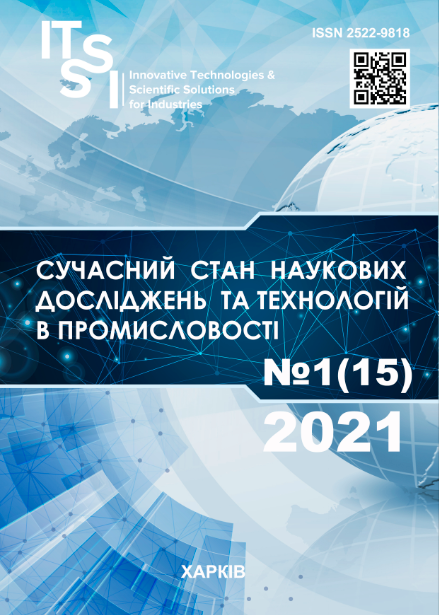MODEL OF THEMATIC INTERPRETOTION OF THE VIEW IMAGES
DOI:
https://doi.org/10.30837/ITSSI.2021.16.005Keywords:
species image, thematic interpretation, decryption, model, geospatial information, geospatial coordinates, segmentationAbstract
The subject matter of the article is thematic interpretation of species images. The goal of the work is to develop a model for thematic interpretation of species images, which will be based on the model for the formation of species images and additionally take into account geographic zoning. The following task was solved in the article: development of a model of thematic interpretation of view images, which takes into account the shortcomings of existing models and is based on the model of formation of view images, carries out the reverse transformation of the image coordinates into geospatial coordinates and clustering the image into separate classes according to their color and texture, additionally taking into account geographic zoning, which provides the possibility of advanced analysis and forecasting the temporal dynamics of data in geospatial information processing systems. The following methods used are – mathematical apparatus of the theory of matrices, methods of mathematical modelling, methods of data clustering, methods of differential calculus, methods of digital image processing. The following results were obtained – groups of existing models for interpreting the results of remote sensing of the Earth, their advantages and disadvantages have been analyzed; a mathematical model of the formation of a species image for a section of the earth's surface has been formulated in general form; a mathematical model of thematic interpretation of species images was formulated in general form; the operator of transformation of coordinates, operators of clustering, operators of zoning and their explicit form are considered; a model of thematic interpretation of species images in operator form is obtained. Conclusions: for the first time, a model of thematic interpretation of view images was developed, which, based on the model of formation of view images, carries out the inverse transformation of coordinates into geospatial coordinates and clustering by their color and texture, additionally taking into account geographical zoning, which provides the possibility of advanced analysis and forecasting of the temporal dynamics of data in processing systems geospatial information.
References
A-Xing, Z., Fang-He, Z., Peng, L., Cheng-Zhi, Q. (2021), "Next generation of GIS: must be easy", Annals of GIS, Vol. 27. P. 71–86. DOI: https://doi.org/10.1080/19475683.2020.1766563
Fu, W., Ma, J., Chen, P., Chen, F. (2020), "Remote Sensing Satellites for Digital Earth", In: Guo, H., Goodchild, M. F., Annoni, A. (eds) Manual of Digital Earth, Springer, Singapore, Р. 55–123. DOI: https://doi.org/10.1007/978-981-32-9915-3_3
Kavats, Yu. V. (2019), "Information technology for decoding anthropogenic changes in satellite images" ["Informatsiina tekhnolohiia deshyfruvannia antropohennykh zmin na suputnykovykh zobrazhenniakh"], Regional interuniversity collection of scientific works "System technologies", Vol. 5, No. 124, P. 77–83.
Penkov, V. O. (2019), Photogrammetry: lecture notes [Fotohrammetriia : konspekt lektsii], Kharkiv : KhNUMG them O. M. Beketova, 100 p.
Dovbysh, A. S., Shelekhov, I. V. (2015), Fundamentals of pattern recognition theory [Osnovy teorii rozpiznavannia obraziv] : textbook in 2 parts, Sumy, 109 p.
Vershovskyi, E. A. (2010), "Interpretation of Earth Remote Sensing Data" ["Ynterpretatsyia dannikh dystantsyonnoho zondyrovanyia Zemly"], System analysis, management and information processing, P. 43–45.
Burrough, P. A., McDonnell, R. A. (1998), Principles of Geographical Information Systems, Oxford, Oxford University Press, 333 p.
Schott, J. (2007), Remote Sensing: The Image Chain Approach / 2nd ed, Oxford, Oxford University Press, 668 p.
Khudov, H. V., Butko, Y.M., Makoveichuk, A.N. (2005), "Theoretical substantiation of the method for selecting reference objects in view images" ["Teorytycheskoe obosnovanye metodyky vibora repernikh ob`ektov na vydovikh yzobrazhenyiakh"], Aerospace engineering and technology, No. 2, P. 92–94.
Zhang, Z. (1998), "A Flexible New Technique for Camera Calibration. MSR-TR-98-71. Microsoft Research", available at : https://www.researchgate.net/publication/3193178_A_Flexible_New_Technique_for_Camera_Calibration (last accessed: 19.01.2020).
Potapov, A. A., Huliaev, Yu. V., Nykytov, S. A., Pakhomov, A. A., Herman, V. A. (2008), The latest methods of image processing [Noveishye metodi obrabotky yzobrazhenyi] / ed. A. A. Potapova, Moscow : Fizmatlit, 456 p.
Shapyro, L., Stokman, Dzh. (2006), Computer vision [Kompiuternoe zrenye], Moscow : Bynom, Knowledge laboratory, 752 p.
Forsait, D., Pons, Z. (2004), Computer vision. Modern hike [Kompiuternoe zrenye. Sovremennii pokhod], Moscow : Vyliams, 928 p.
Zheltov, S.Iu. et al. (2010), Image processing and analysis in machine vision tasks [Obrabotka y analyz yzobrazhenyi v zadachakh mashynnoho zrenyia], Moscow : Fizmatbook, 67 p.
Yong, Y. (2009), "Image segmentation based on fuzzy clustering with neighborhood information", Optica Applicata, XXXIX.
Shumway, R., Stoffer, D. (2010), Time series analysis and its applications : with R examples (3rd ed.), Springer. ISBN 144197864X.
Downloads
Published
How to Cite
Issue
Section
License

This work is licensed under a Creative Commons Attribution-NonCommercial-ShareAlike 4.0 International License.
Our journal abides by the Creative Commons copyright rights and permissions for open access journals.
Authors who publish with this journal agree to the following terms:
Authors hold the copyright without restrictions and grant the journal right of first publication with the work simultaneously licensed under a Creative Commons Attribution-NonCommercial-ShareAlike 4.0 International License (CC BY-NC-SA 4.0) that allows others to share the work with an acknowledgment of the work's authorship and initial publication in this journal.
Authors are able to enter into separate, additional contractual arrangements for the non-commercial and non-exclusive distribution of the journal's published version of the work (e.g., post it to an institutional repository or publish it in a book), with an acknowledgment of its initial publication in this journal.
Authors are permitted and encouraged to post their published work online (e.g., in institutional repositories or on their website) as it can lead to productive exchanges, as well as earlier and greater citation of published work.














